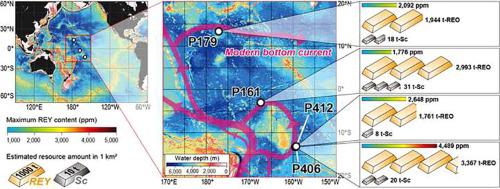Ore Geology Reviews ( IF 3.2 ) Pub Date : 2021-09-05 , DOI: 10.1016/j.oregeorev.2021.104440 Junichiro Ohta 1, 2, 3 , Kazutaka Yasukawa 1, 4 , Kentaro Nakamura 2, 4 , Koichiro Fujinaga 1, 2 , Koichi Iijima 5 , Yasuhiro Kato 1, 2, 4, 5

|
Deep-sea mud enriched in rare-earth elements and yttrium (REY-rich mud) has been recognized as a new resource for REY and scandium (Sc). Recently, highly REY-rich mud with more than 2,000 ppm of REY was found in the western North Pacific Ocean. The high REY content was attributed to enhanced deposition of fish debris, which acts as a host for REY, resulting from fish proliferation caused by topographically induced upwelling of nutrients. To investigate the spatial extent of the highly REY-rich mud, we conducted mineralogical and chemical analyses on selected sediment cores collected near topographic highs in the Central Pacific Ocean. The maximum REY content of the study cores was 4,489 ppm. The correlation between REY contents and abundance of fish debris indicated that the presence of large amounts of fish debris was responsible for the REY enrichment. The results of the mineralogical analysis suggested that there are three layers of REY-rich mud on the basis of the presence/absence of zeolite group minerals in the study cores. The first layer with phillipsite formed as a result of fish proliferation due to interactions between water currents and topography in the latest Eocene to early Oligocene. The layers with clinoptilolite probably formed as the result of an increased depositional flux of fish debris in the equatorial high-surface-productivity area in the middle Eocene. The layer without zeolite group minerals likely formed in relation to increased fish debris production caused by increased biological activity and high ecosystem efficiency together with slow sedimentation of other components in the South Pacific Gyre. Calculation of the resource amount in a 1-km2 area around the study sites, based on mining to the depth where the average grade is maximum when mined from the surface, revealed that the highly REY-rich mud could provide 1.4% of the global annual mine production of REY and 0.8–1.3 times the global annual supply of Sc. This finding suggests that REY-rich mud in the Central Pacific Ocean is a prospective REE resource.
中文翻译:

中太平洋盆地和彭林盆地稀土元素高富集深海泥浆地质特征及资源潜力
富含稀土元素和钇的深海泥浆(富含 REY 的泥浆)已被认为是 REY 和钪 (Sc) 的新资源。最近,在北太平洋西部发现了含有超过 2,000 ppm REY 的富含 REY 的泥浆。高 REY 含量归因于鱼类碎片的沉积增强,作为 REY 的宿主,这是由地形诱导的营养物质上升引起的鱼类增殖造成的。为了调查富含 REY 的泥浆的空间范围,我们对中太平洋地形高点附近收集的选定沉积物岩心进行了矿物学和化学分析。研究岩心的最大 REY 含量为 4,489 ppm。REY 含量与鱼类碎片丰度之间的相关性表明,大量鱼类碎片的存在是 REY 富集的原因。矿物学分析结果表明,根据研究岩心中沸石族矿物的存在/不存在,存在三层富含 REY 的泥浆。在始新世晚期至渐新世早期,由于水流和地形之间的相互作用,鱼类增殖形成了第一层含菱镁矿。斜发沸石层的形成可能是中始新世赤道高地表生产力区域鱼类碎片沉积通量增加的结果。没有沸石族矿物的层可能与由于生物活动增加和生态系统效率高以及南太平洋环流中其他成分的缓慢沉降而导致鱼类碎片产量增加有关。1公里资源量计算2研究地点周围的区域,基于从地表开采时平均品位最大的开采深度,显示富含 REY 的泥浆可提供全球 REY 年产量的 1.4% 和 0.8-1.3 倍Sc 的全球年度供应量。这一发现表明中太平洋富含 REY 的泥浆是一种有前景的 REE 资源。











































 京公网安备 11010802027423号
京公网安备 11010802027423号